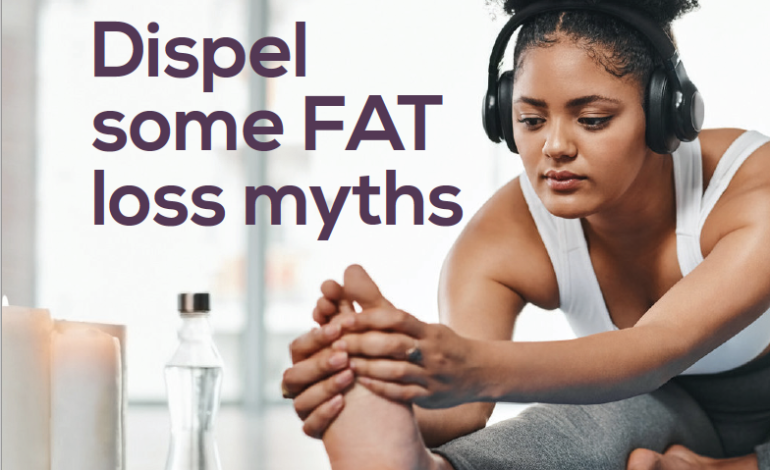5 fat loss myths to dispel

There are many weight loss myths that fly around and when you are desperate to gain back your body, you may fall for them. For example, working out at low intensities isn’t better for fat burning than high intensities. And you can’t just target your tummy with endless sit-ups and expect to lose belly fat. The following fat burning tips will help clear up your confusion and get you slim and toned fast after your weight gain.
Go high intensity
While it is true that when exercising at lower intensities you use a higher proportion of fat as an energy source, you need to remember that you are burning these calories slowly so it is not time efficient, especially when you don’t have all the time in the world for exercise. For example, if a low intensity, 20-minute workout burns off 80 additional calories and even if 90 per cent of them (72) are fat calories, you are still going to be better off doing a 20-minute high-intensity interval session. This is likely to quadruple the overall number of calories burnt (288) and consequently burn a higher number of fat calories (50 per cent of those calories is still 144). High-intensity training also gets you fitter faster– and the fitter you are, the higher your basal metabolic rate, which means you burn more calories, even at rest.
Exercise more frequently
You need to work out as hard as you can for as long as you can to see real benefits. If time is of the essence, short, sharp sessions can still be very effective. Aim to do four to five cardio workouts per week. Try two 20-minute sessions, one 30 to 45-minutes session and two 45 to75-minute sessions a week. If you don’t have time for the longer sessions, do shorter ones rather than skip them. Training for a shorter time but more frequently will give you good results. Warm up for a minimum of five minutes and cool down for a minimum of two minutes. Having a bath in the evening and doing some stretches in front of the TV will help your muscles recover and you will sleep better.
Follow a sensible diet
You can’t get rid of fat in a particular area by just working on that part of your body, for example, belly fat. Some fat areas do tend to metabolize easier than others, though. Fat around your tummy, for example, can be easier to shift than fat around your hips and thighs. The only way to get rid of fat, though, is to do lots of cardiovascular, calorie-burning exercise and to eat a sensible, well-balanced diet. Toning exercises will improve the shape and tone of the muscles, but muscle lies under fat, so to get to it, you need to do the fat burning stuff.
Don’t ignore resistance training
Women tend to prefer cardiovascular exercises such as aerobics or spinning classes to resilience training. There are many reasons for this, such as feeling intimidated in the weights room or the false belief that weight lifting makes you muscular like a man, but increasing your lean muscle tissue can make a big difference to your figure. For example, increasing your lean muscle weight by just half a kilo can burn an additional 50 calories a day. That’s 50 calories every day with no extra effort involved. If conventional weight training isn’t for you, try yoga and Pilates, where strength and power moves are combined. Do weight training two to three times a week.
Avoid faddy diets
Don’t turn to faddy diets to cut down on calories for a quick post-holiday weight loss. This is not a long-term solution to a lean body and just slows your metabolism. Instead, eat healthily and adopt good long-term habits, such as drinking plenty of water, staying away from refined carbohydrates, such as white bread and rice, and reducing your alcohol intake. A healthy diet comprises of lean protein, fruits and vegetables and small portions of unrefined carbohydrates.
This article was first published in the February Issue of Parents Magazine
READ OUR LATEST ARTICLE HERE:




